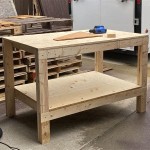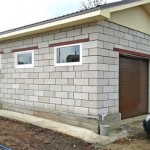Craft a DIY Workbench for Your Home Garages and Buildings
Whether you're an avid do-it-yourselfer or simply enjoy tinkering around with projects, having a sturdy and functional workbench is essential. Building your own workbench allows you to customize it to your specific needs and budget, ensuring a perfect fit for your workspace.
Materials and Tools
To craft a DIY workbench, you'll need the following materials:
- Workbench top: Choose a durable material such as solid wood, MDF, or plywood. Consider the size and thickness appropriate for your projects.
- Legs: Use sturdy materials like 4x4 or 6x6 posts or heavy-duty steel pipes. The height of the legs should align with your desired working height.
- Apron: The apron provides the frame around the legs and supports the workbench top. Use lumber with a thickness similar to the legs.
- Hardware: Gather necessary hardware such as screws, bolts, nuts, washers, and wood glue.
You'll also need tools for cutting, drilling, and assembling the workbench, including a saw, drill, screwdriver, measuring tape, level, and clamps.
Step-by-Step Guide
Follow these steps to build your DIY workbench:
- Create the Legs and Apron: Cut the legs to the desired height, then assemble the apron by connecting the legs with the apron lumber using screws and wood glue.
- Attach the Workbench Top: Place the workbench top on the apron and secure it with screws. Ensure the top is level using a spirit level.
- Add Braces (Optional): For added stability, consider installing braces between the legs and the apron using screws or bolts.
- Reinforce the Top (Optional): If you're using a lightweight workbench top, such as MDF or plywood, consider reinforcing it with a layer of plywood or a steel plate to prevent it from sagging.
- Install Storage Features (Optional): Customize your workbench by adding shelves, drawers, or pegboards for storing tools and materials.
Essential Features to Consider
When designing your DIY workbench, consider these essential features:
- Sturdiness: Ensure the workbench is strong enough to support your projects and tools without wobbling or collapsing.
- Height: Adjust the height of the workbench to match your working posture for maximum comfort and efficiency.
- Size: Determine the appropriate size of the workbench based on the projects you'll be working on and the available space in your garage or building.
- Storage: Plan for adequate storage space to keep your tools and materials organized and within easy reach.
- Versatility: Consider incorporating features that enhance versatility, such as a pegboard for tool hanging or a built-in vise.
Conclusion
Crafting a DIY workbench is a rewarding project that can significantly improve your workspace. By selecting durable materials, following proper construction techniques, and incorporating essential features, you can create a customized workbench that meets your specific needs and enhances your DIY experience.

Build A Basic Workbench Tylynn M

Two Hour Diy Workbench Free Plans Honeybear Lane

And Easy Garage Workbench 3 Steps Instructables

How To Build A Diy Workbench Super Simple 50 Bench

14 Super Simple Workbenches You Can Build The Family Handyman

How To Build A Rolling Workbench Follow This Simple Diy Plan

How To Build A Diy Mobile Workbench With Shelves

Build A Basic Workbench Tylynn M

How To Build A Workbench For Garage Diy And Shelves

14 Super Simple Workbenches You Can Build The Family Handyman
Related Posts








